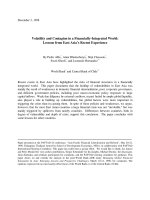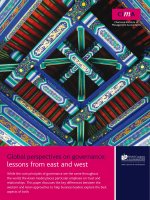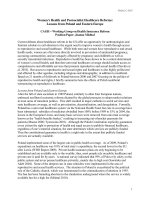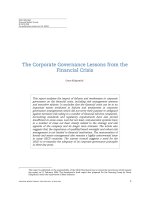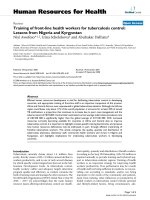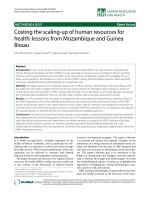Global perspectives on governance: lessons from east and west
Bạn đang xem bản rút gọn của tài liệu. Xem và tải ngay bản đầy đủ của tài liệu tại đây (455.3 KB, 16 trang )
While the core principles of governance are the same throughout
the world, the Asian model places particular emphasis on trust and
relationships. This paper discusses the key differences between the
western and Asian approaches to help business leaders explore the best
aspects of both.
Global perspectives on governance:
lessons from east and west
Conclusions
1.
The corporate governance model that’s familiar in Asia, Africa and most
developing nations places strong emphasis on trust and relationships. This can be
beneficial for stakeholders: the typical pattern of ownership in businesses means
that there can be a longer-term view of an organisation’s success compared with
that in a western company. But the system is potentially vulnerable to corruption
and cronyism. It can also be difficult to implement basic control procedures.
2.
The prestige of what can be broadly termed the western governance model
has diminished in the aftermath of the financial crisis. This model has driven
globalisation and has emphasised a combination of legislation and standards as
well as transparency, with a focus on developing appropriate structures, processes
and frameworks. This is widely understood and helps to create a level playing
field. But major financial failures over the past two years, such as that of Lehman
Brothers, have shown that there are limits to what can be done to tighten checks
and balances. A new emphasis on the behavioural aspects of governance is overdue.
3.
Both models have their strengths and it is important to understand the benefits
and drawbacks of each. CIMA’s model of boardroom leadership is useful in
illustrating the importance of both behavioural and structural issues in achieving
good governance. One particular area where both western and Asian models
remain unduly weak is in creating a culture that allows people in authority to be
challenged constructively.
4.
The key indicator of good governance in an organisation is that it’s sustainable
in the long-term. There should be confidence that the business model will deliver
this, using appropriate risk mitigation, and that performance indicators and
incentives will reinforce the desired culture and behaviour.
5.
Management information that’s relevant, accurate and up-to-date is a
crucial success factor for all organisations worldwide. Professionally qualified
management accountants, bound by a code of ethics, have a vital role in providing
and demonstrating the long-term strategic value of high-quality management
information.
Contents
Introduction 1
The significance of individual relationships in Asia 2
Benefits of trust 5
Balancing the two models 6
1. Case study: Satyam Computer Services 8
2. Case study: Banyan Tree Holdings 9
3. Case study: Toyota 9
4. Case study: Tata Group 10
References and other relevant CIMA publications 11
About CIMA
CIMA, the Chartered Institute of Management Accountants, founded in 1919, is the world’s leading
and largest professional body of management accountants, with 172,000 members and students
operating in 168 countries, working at the heart of business. CIMA members and students work in
industry, commerce and not-for-profit organisations. CIMA works closely with employers and sponsors
leading-edge research, constantly updating its qualification, professional experience requirements and
continuing professional development to ensure that it remains the employers’ choice when recruiting
financially trained business leaders.
About the authors
Victor Smart is CIMA’s head of profile and communications and Gillian Lees is CIMA’s enterprise
governance specialist.
Other CIMA contributors include Naomi Smith (London), Larry Zhang (Shanghai) and Damian Yip
(Hong Kong). We also thank the members of CIMA’s Technical Committee for their valuable comments.
Global perspectives on governance: lessons from east and west | 1
Introduction
Corporate governance can be defined as the way in which organisations are directed and controlled.
Although practices may vary, the core underlying principles of governance are the same throughout
the world. They strive to protect the rights of shareholders, to create an environment of transparency
and appropriate disclosure, and to define the roles and responsibilities of stakeholders in running a
company. These principles are necessary to establish a stable and competitive business and, in the
case of publicly quoted companies, an attractive destination for investment. National economies also
benefit from good governance as a critical component for safeguarding wealth, employment and GDP
growth.
CIMA has long advocated a holistic approach to corporate governance wherever it is practised.
Its philosophy of enterprise governance emphasises that all organisations need to focus on both
conformance and performance. The measure of good governance in a company should be whether the
board of directors is truly focused on the long-term sustainability of the organisation. There should
be confidence that the business model will deliver this, with appropriate risk mitigation, and that
performance indicators and incentives reinforce the desired behaviour.
Broadly speaking, transparency and agreed rules of engagement are
paramount in the west. The focus is on rules (including principles based
accounting standards and codes of practice as well as legislation)
and transparency, creating a level playing field for competitors. This
western model has led globalisation, produced most of the strongest
multinationals and is the bedrock of the world’s developed economies.
Understandably, it is widely viewed as best practice. Major corporate
failures have historically led to the tightening of governance codes and
legislation in order to improve transparency and accountability. But,
in light of the disproportionate impact of the global financial crisis on
western institutions, there is now widespread recognition that there
are limits to what such measures can achieve. There is now much more
emphasis on behavioural issues.
In Asia, Africa and most emerging markets the approach to business
is somewhat different: relationships sometimes take precedence over
transparency. This has its roots in systems in which regulations are
not always strongly enforced and legal redress can take years or even decades. In this environment
business is based on trust and loyalty. The practical emphasis on relationships prevails among most
businesses in these regions, yet many are formally adopting western practices in their journey towards
globalisation at the very time that the financial crisis has cast a shadow over the western governance
model.
John Kay, a leading British economist, recently analysed how the two approaches played out in the
car industry. In a recent column for the Financial Times, he observed: ‘Lawyers for American companies
spent hundreds of billable hours drawing up contracts to which no one ever referred. Their Japanese
counterparts engaged in complex business relationships with no formal agreements at all, or ones
that covered a single sheet of paper. But the commercial relationships that emerged in Japan’s car
industry were more successful in securing component reliability and just-in-time inventory than those
hammered out by the hard-nosed negotiators of Detroit.’
Lawyers for American companies spent
hundreds of billable hours drawing up
contracts to which no one ever referred.
Their Japanese counterparts engaged
in complex business relationships with
no formal agreements at all, or ones
that covered a single sheet of paper.
But the commercial relationships that
emerged in Japan’s car industry were
more successful in securing component
reliability and just-in-time inventory than
those hammered out by the hard-nosed
negotiators of Detroit.
2 | Global perspectives on governance: lessons from east and west
Business leaders in the east and west who understand the differences and can extract the best from
both styles may stand to benefit. On the other hand, underestimating the challenge can cause
problems. Some western companies stumbled as they expanded into Asia when their rules-based
processes clashed with the local culture, for example. At the same time, eastern companies aspiring to
become powerful multinationals found that their personal networks became strained and ineffective
when stretched across vast distances and different cultures.
This report takes a closer look at the eastern model and analyses its
advantages and disadvantages. It also discusses the role of management
accountants in finding a common ground between the models. Many
would agree that the challenge for Asian companies is to retain the
advantages of individual relationships while finding tools to compensate
for the disadvantages. The challenge for management accountants is
to recognise the benefits inherent in the eastern model and to guide a
strategy that mitigates the dangers without diluting these benefits.
Now that the western model of governance looks far more fallible than it did before the global
financial crisis, the time is ripe for examining the model that helped to insulate Asian companies from
the worst of its effects. If the western model were to lose its pre-eminence and the Asian alternative
were to gain followers globally, what else would be lost and gained? The basis of such a model could
be CIMA’s boardroom leadership framework, which stresses the importance of people and behavioural
issues as well as appropriate frameworks, processes and structures. This is considered in a subsequent
section entitled ‘Balancing the two models’ (page 7).
The significance of individual relationships in Asia
Individual relationships have been an integral part of business for centuries throughout Asia.
Entertaining and getting the measure of your prospective business partner were often the first steps
in making a deal, well before benefits and money were even mentioned. Relationships in companies
could trump performance and leaders were greatly respected – their word was law and their decisions
indisputable.
While giving individual relationships such weight creates difficulties, it
also brings advantages that can easily be overlooked. A 2003 white paper
on corporate governance in Asia by the Organisation for Economic
Co-operation and Development (OECD) noted: ‘The informal nature of
Asian stakeholder/company interaction can produce real and lasting
benefits for stakeholders that equal or exceed those offered through
more formalistic approaches based on “rights”.’ The paper also noted that,
with the advent of globalisation, there was an increasing tendency in Asia
towards creating more formal corporate structures.
2
Furthermore, John Hooker, Professor of business ethics and social
responsibility at the Tepper School of Business, discussing various shades
of nepotism and cronyism, recently wrote: ‘Many such cultural differences
arise from the fact that western cultures are built on rules and transparency, while most of the world’s
other cultures are relationship based. Westerners trust rule based institutions; others trust their friends
and family far more and are therefore especially keen to cultivate strong relationships.’
3
The informal nature of Asian
stakeholder/company interaction can
produce real and lasting benefits for
stakeholders that equal or exceed
those offered through more formalistic
approaches based on “rights”.
Many such cultural differences arise
from the fact that western cultures are
built on rules and transparency, while
most of the world’s other cultures are
relationship based. Westerners trust rule
based institutions; others trust their
friends and family far more and are
therefore especially keen to cultivate
strong relationships.
Global perspectives on governance: lessons from east and west | 3
When doing business with Asian partners, western companies are often hindered as they grope
through an unfamiliar landscape. Companies and business units in Asia are often run by the founders
and their relatives. Supply contracts tend to go to trusted friends, while knowing the right person in
the right place could mean a difference of months, if not longer, in securing a licence or a key meeting.
Jean-Luc Chéreau was already an old hand in Asia before moving to China in 1999 to run French
retailer Carrefour’s operations there, but he still faced surprises. When he arrived in Shanghai, the
company had five contracts in hand for new stores in the country, but he noticed progress with one
local partner was slow. In an interview with McKinsey Quarterly in 2006 he explained: ‘Finally my
assistant told me: “Just because he signed a 20 year contract two years ago with your former boss – a
person who is not you – does not mean he will respect the contract.” That was a big shock to me: the
contract was notarised and everything. But we started to renegotiate article by article.’
4
The reasons that relationships can still mean more than legal contracts are rooted in cultures that
value family ties and, by extension, the bonds of friendship highly. Also, until recently in some Asian
countries, a political and legal climate in which governments and
bureaucracies were seen as unfair reinforced these bonds by making
trust a valuable commodity. Asian markets remained immune to the
obsession with shareholder value that swept western markets in the
1980s and peaked in the 1990s, while few family-owned businesses
in the region succumbed to the flood of hostile takeover bids that
had overwhelmed their western equivalents. The OECD white paper
observed that about two-thirds of businesses in Asia were family-
controlled in 2003 (defining control as at least a 20% stake). In
addition, national governments still own significant stakes in a wide range of Asian businesses,
including many publicly traded companies. This has imposed another web of key relationships.
These factors have combined to reinforce the importance of relationships among Asian companies,
including those in Japan, the most developed economy in the region. In his book Keeping Better
Company, Jonathan Charkham lists three key concepts that govern Japanese culture: a sense of
obligation based on relationships, the importance of family (including the corporate family) and the
need for consensus.
5
‘When a Chinese company, whether a state-owned enterprise or a
private company, makes a decision it always comes into so many
issues, and the final outcome will be determined by measuring the
impact on people,’ says Ellena Au FCMA, Chief Executive of KanTec
Business Consulting in Beijing. ‘Sometimes we say that Chinese
companies are not scientific or fact based, because they’re always
considering so many people issues. These considerations make it more
difficult than it is in the west to be sure where you look at data, sales
growth, profit growth etc.’
By placing so much emphasis on individual relationships, Asian firms find it harder to implement
procedures that are considered best practice in the west, particularly those that increase transparency
– e.g., performance based evaluations. Their employees can view even basic control tools as a lack of
trust in them.
When a Chinese company, whether
a state-owned enterprise or a private
company, makes a decision it always
comes into so many issues, and the final
outcome will be determined by measuring
the impact on people.
Sometimes we say that Chinese
companies are not scientific or fact based,
because they’re always considering so
many people issues. These considerations
make it more difficult than it is in the
west to be sure where you look at data,
sales growth, profit growth etc.
4 | Global perspectives on governance: lessons from east and west
One of the most prevalent problems is a reluctance to question decisions made by a superior.
Obedience to father figures is easily transferred to obedience to anyone in authority. This is
exacerbated in some companies where the chairman is the founding patriarch. In his 2008 book
Outliers, Malcolm Gladwell cited an example in which such deference to authority had fatal
consequences. In the 1980s and 1990s national flag carrier Korean Air had one of the world’s worst
safety records and its aircraft suffered a series of fatal crashes. Gladwell attributes the problem, in
part, to the inability of junior flight officers to challenge a captain’s actions, even when disaster was
imminent.
‘Among Korean Air flight crews, the expectations on layovers used to
be that the junior officers would attend to the captain to the point of
making him dinner or purchasing him gifts,’ Gladwell wrote. ‘As one
former Korean Air pilot puts it, the sensibility in many of the airline’s
cockpits was that “the captain is in charge and does what he wants,
when he likes, how he likes and everyone else sits quietly and does
nothing.”’
6
While Korean Air was able to change this mentality, partly by switching to English as its
working language, a similar culture is still prevalent in many Asian companies.
Asian society’s lack of transparency creates a fertile ground for corruption, too. Without open tenders
or other checks and balances, for example, the temptation to offer incentives such as kickbacks to seal
a deal can be overwhelming. The same is true for employees whose success rests on their relationship
with their superiors. Even so, Hooker believes that what westerners like to attack as corruption might
not be a black-and-white issue. It may actually be good business, given the Asian context, he argues.
‘We typically identify corruption with side-payments, cronyism and nepotism, but all those activities
can be entirely legitimate when practised responsibly in the right cultural context,’ he wrote. ‘A
purchasing agent in Taiwan may award a contract to an old friend rather than the lowest bidder
because the friend can be trusted to deliver a good product. That kind of responsible cronyism (known
as guanxi) has been a foundation of business in Taiwan [and indeed in East Asia as a whole] for
centuries. It becomes corrupt only when the agent favours friends simply because they are friends,
rather than because they can be trusted to do the job right.’
3
Satyam Computer Services, once one of India’s most respected outsourcing firms, went out of business
after a scandal that may have been prevented had there been more transparency or questioning within
the company. In early 2009 its founder and chairman, B Ramalinga Raju, resigned, saying he had hidden
a $1bn cash shortfall for years (see case study, page 9). The scandal exposed ‘a patriarch willing to go
to any length to keep control, a web of cosy relationships among members of a seemingly untouchable
elite and a governance system that failed to keep either in check’, according to a report in the New
York Times.
7
The article quoted Ajay Gandhi, an accountant in Satyam’s home base of Hyderabad, as
saying that even outside accountants were unwilling to question the company’s chairman, whom they
considered to be their client. ‘Raju would have been the owner, so what he wanted here would have
been done,’ Gandhi said.
A purchasing agent in Taiwan may award
a contract to an old friend rather than the
lowest bidder because the friend can be
trusted to deliver a good product.
Global perspectives on governance: lessons from east and west | 5
Benefits of trust
Criticism of the eastern corporate governance model has been blunted by the simple fact that Asian
companies, even those in the financial services industry, have generally weathered the global financial
crisis better than those in the west. The most significant impact they have felt came not from risky
lending, but from declining demand from consumers in North America and Europe. There was no Asian
Lehman Brothers splashed across the headlines, with revelations about the exploitation of Repo 105
accounting procedures to shift $50bn off the balance sheet. Instead, China’s biggest banks – Industrial
and Commercial Bank of China, China Construction Bank and Bank of China
– are now the world’s first-, second- and third-largest banks respectively by
market capitalisation.
The reasons that Asia remained relatively isolated from the shocks of the
financial crisis go well beyond corporate governance: governments such as
those of China and Singapore were able to respond quickly; immature capital markets had yet to move
into riskier and less understood debt vehicles; and strong domestic credit demand limited exposure
to sub-prime loans and their variants in the US and elsewhere. And there was another contributory
factor: the proprietary and even patriarchal link between Asian corporate leaders and their businesses
instils a longer-term view than that held by many western executives of a company’s success. Asian
business leaders tend to see themselves as custodians of valuable property that will be passed on to
future generations. This view inspires a more cautious approach to risk, a deeper understanding of the
business itself and a willingness to sacrifice short-term gains for long-term health. ‘There’s no doubt
in my mind that this approach creates a focus on the long-term,’ says Charles Tilley, CIMA’s Chief
Executive.
Such stewardship can go beyond the company itself and encompass wider society. With their fixation
on shareholder value, many western companies cannot entertain the view that the ultimate purpose
of business is not to create profit, but to serve society. Profit is simply the fuel needed to continue
serving society. Jack Welch, credited by many with triggering the west’s intense focus on shareholder
value in a speech he made in 1981 as CEO of General Electric, said last year that, by itself, ‘shareholder
value is the dumbest idea in the world’.
8
And the big problem in the west is that share ownership in
some countries has become so dispersed, with a small proportion of shareholders willing to exercise
responsible stewardship, that we now have what’s been described as the phenomenon of ‘ownerless
corporations’.
Ho Kwon Ping, Executive Chairman of Singapore based firm Banyan Tree Holdings (see case study, page
10), says: ‘If you flip through all the business textbooks nowadays, you see terms such as “maximising
shareholder value” “economic profit” and so on. But they never mention that, in a world where there’s no
more communism or socialism and where capitalism is the most powerful driver of economic growth,
well-being and development, the fundamental mission of business is to make a better world. CEOs have
the social responsibility to provide leadership and values, not just maximise shareholder value.’
9
CIMA’s Charles Tilley has a similar perspective. ‘The key responsibility of company boards, wherever they
are located, is to ensure the long-term sustainability of their businesses. The recent financial crisis in the
west has led many to question whether the heavy focus on maximising shareholder value is the best
way of achieving this goal and to reconsider the role of business. There is much the west can learn from
the eastern approach, in particular the emphasis on the long-term and the view that the fundamental
purpose of business is to help improve the well-being of the wider community. If in running a company,
the aim of management is purely short-term shareholder value creation, the enterprise may wind up
failing to build a sustainable business or contributing to society generally’ he says.
CEOs have the social responsibility to
provide leadership and values, not just
maximise shareholder value.
6 | Global perspectives on governance: lessons from east and west
John Kay has observed competitive advantages derived from structures of implicit contracts with
suppliers, employees and customers. In his FT column he cited the renowned British retailer Marks
and Spencer as an object lesson in what happens when a company turns its back on these in pursuit
of shareholder value. ‘If the success of M&S demonstrated the power of relational contracting, the
company’s decline illustrated a process that swept across business – and above all the financial
sector – from the 1980s,’ he wrote. ‘The substitution of transaction-oriented dealings for relationship
contracting added to profitability in the short run, but in the long run it eroded relationships that had
been the underlying source of much of that profitability.’
1
Balancing the two models
Giving relationships pre-eminence can expose fault-lines in governance: failures and fraud can go
undetected, systems that lack transparency become more susceptible to corruption and the rights of
minority shareholders are jeopardised, for instance. But, as the global crisis has shown, the western
model also carries its share of risk, including an intense focus on short-term shareholder value that
can overshadow the prospects of long-term sustainability. The weaknesses of both models must be
addressed as the global economy enters a new era, and their advantages preserved. Shareholder value
and trusted relationships are not exclusive. They can (and possibly should) co-exist in a governance
model that balances the two approaches. CIMA’s boardroom leadership framework provides a useful
basis for understanding the relative merits of the two models (see panel).
P
e
o
p
l
e
a
n
d
b
e
h
a
v
i
o
u
r
s
F
r
a
m
e
w
o
r
k
s
,
p
r
o
c
e
s
s
e
s
a
n
d
s
t
r
u
c
t
u
r
e
s
Boardroom
leadership
Supportive
challenge
culture
Professional behaviour
• Values/ethics
• Mutual respect
• Tone at the top
Board composition
• Experience
• Diversity
• Independence
• Time
Talent development
and reward
• Succession planning
• Risk and
remuneration
Agendas and toolsInformation
and reporting
Roles and
responsibilities,
committees
Risk awareness
B
r
o
a
d
e
m
p
h
a
s
i
s
o
f
A
s
i
a
n
g
o
v
e
r
n
a
n
c
e
B
r
o
a
d
e
m
p
h
a
s
i
s
o
f
w
e
s
t
e
r
n
g
o
v
e
r
n
a
n
c
e
Global perspectives on governance: lessons from east and west | 7
The CIMA boardroom leadership framework
This was designed to illustrate how a number of critical factors are necessary to achieve board
effectiveness – and, by implication, good governance.
10
It can be applied to understand the Asian and
western corporate governance models.
The diagram is divided into two halves:
• people and behaviour
• frameworks, processes and structures.
Broadly speaking, the Asian model has placed relatively more weight on the
people and behavioural aspects of governance, while the western model has
tended to address structural and process issues. (Note that this is not a hard
and fast distinction, and also that creating an organisational culture that
allows leaders’ decisions to be questioned constructively is a challenge under
both models).
But, as we have seen, the financial crisis is leading to a reappraisal of western approach: more attention
is being paid to behavioural issues. And, while the Asian model emphasises relationships, it is important
to recognise the need for supporting tools and frameworks to ensure that decisions are made for sound
reasons – i.e., whether work will be done properly – and not purely to maintain a relationship.
The main purpose of the framework is to illustrate the mutually reinforcing value of both dimensions
of good governance and how the benefits of the western and Asian models can be applied to each
other.
Western-style rules and transparency have been shown to aid corporate governance, although
corporate governance by itself cannot ensure success, of course. In Asia, where so many businesses
are controlled by majority shareholders, companies’ fortunes are more directly intertwined with the
interests of their ‘owner-shareholders’. Minority shareholders, on the other hand, can be classed as
‘investor-shareholders’, who have shorter attention spans and may simply be looking for quick returns.
These two groups have divergent interests. Investor-shareholders have only
one stakeholder role – that of shareholder – and they are generally seeking
only personal benefits. Owner-shareholders are possibly more accepting
of multiple stakeholder roles, as they may feel a more direct responsibility
towards business associates, employees and the community, at which level
personal relationships play an important role. But beyond the relationship
level there may be a diminished acceptance of stakeholder responsibility,
such as towards the environment, which is where the western governance model may be more
effective through stricter regulation and enforcement.
Yet, while the relationship based model promotes longer-term thinking, rules and transparency are
essential in helping to prevent the excesses of individuals, especially those at the top of the corporate
ladder. ‘Old-boy networks’, as they are known in the west, can often hide dealings that are illegally
detrimental to competition, customers and community alike. Many western standards and laws have
been set in place specifically to break these opaque networks.
Shareholder value and trusted
relationships are not exclusive. They
can (and possibly should) co-exist in
a governance model that balances
the two approaches.
A key task of the professional
accountant in business is to
demonstrate in practice the
long-term strategic value of the
right information.
8 | Global perspectives on governance: lessons from east and west
In practice, many multinationals from the east and west have approached finding a balance by mixing
employees from the home office with local staff, particularly in senior roles. Managed badly, this
structure can create damaging conflicts between expatriate and local views. Managed well, it can
create a healthy tension that brings out the best of both views. Sophisticated recruitment policies
are crucial to crafting a functional team, as are performance metrics that are customised for local
contexts.
It is important not to overlook the powerful and fundamental role
of management accountants in providing the most relevant and
accurate management information to business leaders, wherever
the business is located and however it is governed. One possible
danger in a top-down management culture is that the integrity
of the management information is compromised because people
are afraid of telling their bosses anything they don’t want to
hear. The professionally qualified accountant, bound by a code of
ethics, has a duty to resist this temptation. A key task of the professional accountant in business is to
demonstrate in practice the long-term strategic value of the right information.
In helping companies in both the east and the west find this balance, management accountants must
be careful not to impose haphazardly western models that have their own intrinsic faults. Instead,
they would be wise to understand the benefits that relationship based models offer and help to create
a system that mitigates the disadvantages and keeps the advantages through appropriate financial
plans, incentive structures and information systems. Those who are successful will build tremendous
shareholder value.
Wim Van der Stede, CIMA professor of accounting and financial management at the London School of
Economics, summarises this idea pertinently. ‘I don’t know of a senior finance professional who is not
under pressure from others around their organisation. The difference may be that in the west they face
pressure from the executives to show bigger returns for stock markets, whereas in the east they may
be under pressure from a powerful majority shareholder to pinch profits from minority shareholders.
But they are always between a rock and a hard place. The rock and the hard place are just different
parties.’
1. Case study: Satyam Computer Services
At the end of 2008 Satyam Computer Services was one of the darlings of India’s IT outsourcing sector.
It was the country’s fourth-largest IT services company, with annual revenues of well over $1bn. Its
clients were spread across the globe and included a healthy swathe of Fortune 500 companies. The firm
was winner of the World Council for Corporate Governance’s Golden Peacock Award and a few years
earlier Ernst & Young had named Satyam’s founder and chairman, B Ramalinga Raju, Entrepreneur of
the Year.
That all changed on 7 January 2009, when Raju resigned, confessing to hiding about $1bn in cash
shortfalls. In a letter made public, Raju admitted that he had been fixing the books for seven years.
When a deal to buy his sons’ development companies fell through, the effort was no longer tenable.
He wrote: ‘It was like riding a tiger, not knowing how to get off without being eaten.’
In the immediate aftermath, Raju, his brother and the company’s chief financial officer were jailed on
charges related to the fraud. The company was sold to Tech Mahindra in a public tender and its name
changed to Mahindra Satyam. Satyam Computer Services was no more.
The difference may be that in the west they
face pressure from the executives to show
bigger returns for stock markets, whereas in
the east they may be under pressure from
a powerful majority shareholder to pinch
profits from minority shareholders.
Global perspectives on governance: lessons from east and west | 9
A year after news of the scandal broke, Arun Duggal, former CEO of Bank of America in India, wrote
that there had been ‘a steady improvement in the functioning of boards’ in India and that independent
directors had become more involved in overseeing the affairs of their companies and protecting
minority rights. Duggal also praised the government’s effort to create voluntary guidelines. ‘The
Satyam fiasco, although very painful, has resulted in actions to improve the corporate governance in
India, but there remains much more to be done,’ he wrote.
11
2. Case study: Banyan Tree Holdings
Banyan Tree Holdings, a Singapore based leisure group, began life in 1994 when founder Ho Kwon Ping
opened a luxury holiday resort in Thailand in a bid to move his family business away from contract
manufacturing. At the time he was quoted as saying that was seeking a business that could be built on
brand reputation and in an industry that would not easily be taken over by Chinese companies.
Despite the crises that pounded Asia’s tourism industry, including economic downturns, the SARS
epidemic and terrorism, the company quickly expanded its network of resorts, spas and hotels,
eventually branching out into luxury consumer labels. Banyan Tree became ‘one of the world’s
most lauded luxury boutique-hotel brands,’ according to the Wall Street Journal. Revenues in 2008
were $293m, down slightly from a record year in 2007, largely because of the closure of Bangkok’s
international airport owing to political unrest. Among its portfolio, Banyan Tree counted 25 hotels and
68 spas in 23 countries, with plans to expand further over the next four years.
Throughout his tenure, Ho has managed with a very personal style, visiting with employees and
customers regularly. In a 2008 column for Singapore newspaper The Straits Times, he wrote: ‘As East
Asia emerges as a major economic region, it should not simply adopt the Anglo-American or European
models, but create its own alternative. The common, recurring socio-ethical tradition of East Asia
is its communitarian, family-focused webs of mutual obligations. This communitarianism can, if
thoughtfully enhanced, nurtured and developed, replace the highly individualistic Darwinian ethos of
Anglo-American capitalism or the state welfarism of Euro-capitalism.’
12
He continued: ‘Of course, critics will argue that this neo-Confucian capitalism is compatible with crony
capitalism, as the 1997 Asian financial crisis highlighted. They have a point. But the flaws of East Asian
culture do not negate the need to develop a socio-cultural alternative to the Wall Street ethos. Indeed,
they only make more urgent that East Asian thought leaders refine and redefine neo-Confucian values.’
3. Case study: Toyota
Toyota is an interesting example of an Asian company that has run into recent problems – arguably
because it lost touch with its traditional strengths.
Founded in 1933, Toyota became the world’s largest car maker by sales in 2008, overtaking General
Motors in the process and building a 12% share of the global car market. It has long been regarded
as one of the world’s most admired companies and has built a reputation for engineering excellence
based on a philosophy known as the Toyota Way. At the heart of this is a long-term approach to
problem solving even at the expense of short-term goals. Through its development of such concepts
as lean manufacturing and just-in-time inventory management, Toyota has had a profound influence
on manufacturing throughout the world. With the Prius, it also created the first hybrid car, setting
standards for others to follow.
10 | Global perspectives on governance: lessons from east and west
However, more recently, its reputation has been tarnished by the recall of eight million cars due to
mechanical failures which US regulators believe have been responsible for over 50 deaths.
Commentators have suggested that Toyota’s push for robust cost-cutting and rapid expansion since
1995 put the company under too much strain. Toyota boasted $10bn in savings over six years up to
2005. It then went even further by slashing the time from design to production to about 12 months
compared to the industry average of 24-36 months. In the end, something had to give – and that
was quality. A US parts supplier, on inspecting a Toyota Camry in 2007, was, for example ‘surprised by
how much the traditional Toyota craftsmanship had been watered down by years of nips and tucks’.
Toyota’s former top US executive recently argued that the company had lost its customer-first focus
as it had been effectively been hijacked by ‘anti-family, financially oriented pirates’.
Earlier this year, the grandson of the company founder admitted to a US congressional committee that
he feared that the company had grown too quickly. He said, ‘Priorities became confused, and we were
not able to stop, think, and make improvements as much as we were able to before’. There are early
signs that Toyota’s sales are rebounding in response to substantial discounts, but there is little doubt
that Toyota executives will be looking to recapture the traditional virtues of the Toyota Way.
4. Case study: Tata Group
Since its founding 142 years ago, the Indian based Tata Group has become one of the world’s largest
conglomerates – or ‘family’ as its own executives prefer to call it. It is now a $70.8bn commercial
enterprise which employs 350,000 people in 80 countries across a wide array of business sectors
including cars, steel, hotels, IT and tea. The Tata name is becoming more widely known globally in the
light of recent high profile acquisitions such as Jaguar Land Rover and the Anglo-Dutch steel company,
Corus. It is currently in its fifth generation of family stewardship and is respected for its adherence to
strong values and ethical principles.
The distinctive feature about Tata is its commitment to investing in community and human
relationships. Indeed, the community is regarded as the very purpose of Tata’s existence. All
the constituent businesses in the group earmark part of their operating expenditures to social,
environmental or ethical programmes. In 2009, social expenditure was over $159m.
Since the early 1990s, Tata has undertaken an ambitious programme of global expansion in response
to the opening up of the Indian market to foreign investment and the removal of exchange controls.
This has not been without its challenges, for example, managers are having to apply their expertise to
labour relations in non-Indian markets. Tata was criticised for the way it dealt with the closure of a
Jaguar Land Rover factory in the UK.
Nevertheless, Tata appears to have emerged relatively strongly from the recent financial crisis.
However, it will be interesting to see whether Tata can continue to maintain its global expansion
strategy while sticking to its core founding values. If it succeeds, it could provide an example for other
companies seeking to run sustainable, responsible businesses.
Global perspectives on governance: lessons from east and west | 11
References
1. John Kay, ‘Think before you tear up an unwritten contract’, Financial Times, 17 March 2010.
2. OECD, White Paper on corporate governance in Asia, 2003.
3. John Hooker, ‘What is corruption? It’s not so simple’, Forbes.com, 4 January 2010.
4. Peter Child, ‘Lessons from a global retailer: an interview with the president of Carrefour China’,
McKinsey Quarterly, June 2006.
5. Jonathan Charkham, Keeping better company, Oxford University Press, 2005.
6. Malcolm Gladwell, Outliers: The Story of Success, Little, Brown and Company, 2008.
7. Heather Timmons and Jeremy Khan, ‘Past graft is tainting new India’, New York Times, 20 January
2009.
8. Francesco Guerrera, ‘Welch denounces corporate obsessions’, Financial Times, 13 March 2009.
9. Economist Intelligence Unit, ‘Businesses re-imagined: social value above shareholder value?’
7 December 2009.
10. CIMA, ‘Enterprise governance: restoring boardroom leadership’, January 2010.
11. Arun Duggal, ‘What have we learned in the year since Satyam?’ Wall Street Journal, 7 February
2010.
12. Ho Kwon Ping, ‘Banking on neo-Confucian capitalism’, The Straits Times, 27 August 2008.
13. Alan Ohnsman, Jeff Green, Kae Inoue, ‘The Humbling of Toyota’, Bloomberg Businessweek, 22/29
March 2010.
14. Ann Graham, ‘Too good to fail’, Strategy + Business, Issue 58, February 2010.
Other relevant CIMA publications
• Kenneth Merchant and Xiaoling Chen, ‘Strategy mapping: an examination of a homebuilder’s
performance measurement and incentive systems’, CIMA Research Executive Summaries series,
Volume 5, Issue 6, July 2009.
• Kenneth Merchant and Tatiana Sandino, ‘A test of a company’s business model’, CIMA Research
Executive Summaries series, Volume 5, Issue 10, December 2009.
• CIMA, ‘CIMA Strategic Scorecard™: boards engaging in strategy’, March 2007.
• Wim Van der Stede, ‘Enterprise governance’, Financial Management, February 2009.
All are available from www.cimaglobal.com
To comment on this report, email
ISBN: 978-1-85971-654-0 (PDF)
Chartered Institute of
Management Accountants
26 Chapter Street
London SW1P 4NP
United Kingdom
T. +44 (0)20 7663 5441
E.
www.cimaglobal.com
For more information on CIMA’s international offices
please visit www.cimaglobal.com/our-locations
© 2010, Chartered Institute of Management Accountants PR011V0610
